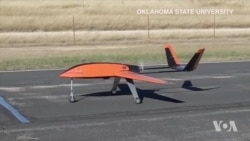Scientists are developing unmanned planes -- called drones -- that can gather weather information from the atmosphere.
The drones could help weather experts improve their predictions.
Meteorologists say their weather forecasts would be more accurate if they had information from many parts of the atmosphere. They already place satellites, drones and balloons at different altitudes. And they use radar and gather information from devices on towers.
But that information only helps experts predict weather conditions for the next few days. It does not help predict changes in the next few hours. This is very important where sudden, violent storms happen.
So scientists at Oklahoma State University are developing new drones to gather information from more parts of the Earth’s atmosphere. This will help forecasters improve predictions about local weather conditions.
Jamey Jacob is an aerospace engineer and a professor of mechanical and aerospace engineering at Oklahoma State University. He leads the university’s Unmanned Systems Research Institute.
He and other scientists at the university are developing small drones that do not cost a lot of money but can fly for hours, gathering information from many atmospheric levels. He spoke to VOA on Skype.
“Oklahoma is a really good, good example, because even though we're already a very weather-dynamic state, Oklahoma only has two balloon launches a day -- one at dawn and one at dusk -- from a single location in the state, and that's where all the weather forecasting information comes from. So that data is really sparse, and it’s difficult for meteorologists that are developing these forecasting models to get a very good idea about how that weather is changing from these very limited number of data points.”
Phillip Chilson is a professor of meteorology at Oklahoma State University. He says the drone program should give researchers a low-cost way of understanding storms better, and improve computer-based forecasting.
The scientists have developed a round drone that can fly, hover, roll on the ground and then take off again. These abilities are needed for a drone to fly in storms.
Professor Chilson says the drone can measure atmospheric conditions, send live video to forecasters, and help search for people hurt in storms. He spoke to VOA on Skype.
“Our real goal is to try to develop systems that really, I don't want to say replace but there may be that possibility of replacing weather balloons, but currently augmenting them -- so, increasing the capabilities.”
Researchers say they still have a lot of work to do before the drones are ready. That includes making sure the drones know how to stay away from other planes. They say it could be two years until a drone can safely examine Earth’s lower atmosphere.
I’m Christopher Jones-Cruise.
VOA's Science and Technology Correspondent George Putic reported on this story. Christopher Jones-Cruise adapted it for Learning English. Kathleen Struck was the editor.
We want to hear from you. Write to us in the Comments Section, or visit our Facebook page.
________________________________________________________________
Words in This Story
drone – n. a plane or other vehicle that flies and does not have a pilot in it
meteorologist – n. a scientist who studies the atmosphere and weather
forecast – n. a statement about what you think is going to happen in the future
accurate – adj. free from mistakes or error
altitude – n. the height of something (such as an airplane) above the level of the sea
dynamic – adj. always active or changing
dawn – n. the time of day when sunlight first begins to appear
dusk – n. the time when day changes into night and the sky begins to get darker
sparse – adj. present only in small amounts; less than necessary or normal
data point – n. facts or information used usually to calculate, analyze or plan something (usage note: data is plural in form but is used with both plural and singular verbs)
hover – v. to float in the air without moving in any direction
scope – n. the area that is included in or dealt with by something
capability – n. the ability to do something
augment – v. to add something to (something) in order to improve or complete it








